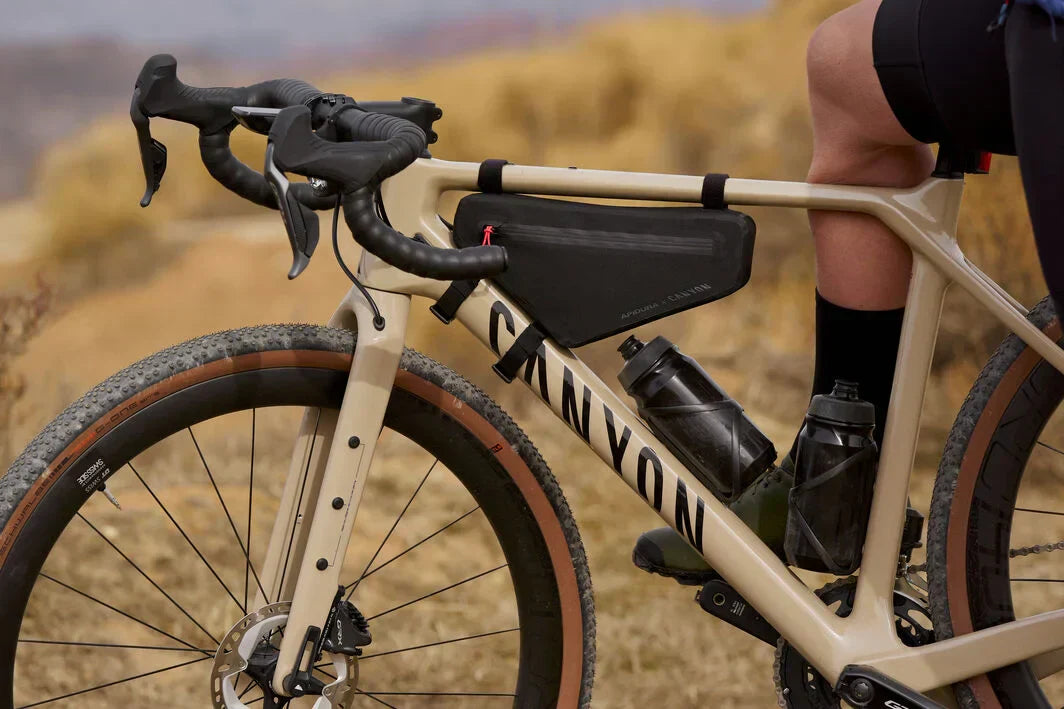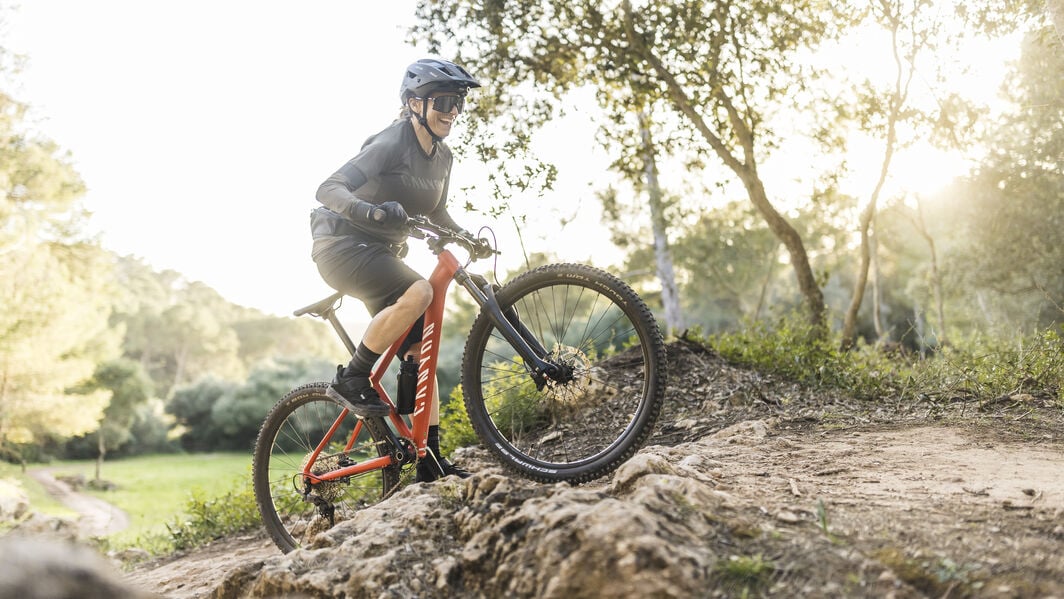
Gravel Bike vs. Hardtail MTB: Which one is right for you?
Share
Explore the key differences between gravel bikes and hardtail mountain bikes. Compare features, performance, and terrain compatibility to help you make the best choice.
Maybe you’ve heard people say that modern gravel bikes are "just 90s hardtail mountain bikes with drop bars." While it’s a catchy phrase, this comparison doesn’t quite hold up – especially considering how far hardtails have evolved since the 90s. In this guide, we’ll break down the distinctions between gravel bikes and hardtail mountain bikes, examining which terrains they are best at on and how they perform.
Contents
- Gravel Bike vs. Hardtail MTB: Geometry Differences
- Tyre Differences Between Gravel and MTB
- Performance Comparison: Speed, Stability, and Handling
- Gearing Up: Accessories and Equipment for Your Bike
- Ride Experience: Gravel vs. Hardtail
- Maintenance and Durability: Long-Term Considerations
- Choosing Between a Gravel Bike and a Hardtail MTB
Gravel Bike vs. Hardtail MTB: Geometry Differences
Gravel bikes, often called all-road bikes, take inspiration from endurance road bike geometries but incorporate modifications for added stability on rough terrain. Models like Canyon’s performance gravel bike, the Grail, feature a longer wheelbase and a slacker headtube angle than traditional road bikes, boosting confidence on off-road routes. Additionally, gravel bikes typically have wider handlebars with flared drops, improving control over technical sections and offering versatile riding positions.
Hardtail mountain bikes, on the other hand, prioritize stability and pedaling efficiency. They feature a longer wheelbase and steeper headtube angles for a more upright riding position. This geometry results in quicker handling at lower speeds but may feel sluggish on smoother terrain. While hardtails lack rear suspension, they still roll efficiently on flatter surfaces thanks to their front suspension fork.
Gravel bikes have a more aggressive riding position than hardtails but are less aggressive than performance road bikes.
Hardtails offer a more upright stance and increased stability on rough terrain but handle slower on flat, smooth surfaces.
Tyre Differences Between Gravel and MTB
Tyre size plays a crucial role in the ride feel of a bike. Gravel bikes are designed to maneuver around obstacles rather than plowing through them, leading to smaller tyres compared to hardtail MTBs.
However, there’s some overlap as gravel riders increasingly seek frames with greater tyre clearance. For example, the Grizl can accommodate tyres up to 50mm.
Gravel tyres typically range from 32mm to 55mm (1.5” to 1.9”).
Mountain bike tyres generally start around 45mm (1.8”) and can exceed 66mm (2.6”).
Beyond width, tread patterns also differ. Gravel tyres have a less aggressive tread for smoother performance on roads and light trails, whereas the knobbier treads of MTB tyres provide superior grip on rocky terrain but create more drag on pavement.
Gravel Bikes are a hybrid between MTB and Roadbike:
Performance Comparison: Speed, Stability, and Handling
The geometry and tyre differences translate into distinct riding experiences, so consider your priorities before choosing.
- Speed: Gravel bikes are designed for fast riding on mixed terrain. Their road-bike similarities make them efficient on pavement and smooth surfaces. However, their lack of suspension and narrower handlebars can make rough descents feel unstable.
- Stability: Hardtails shine on technical downhills, with their suspension fork and optional dropper posts enhancing control. However, their upright position and added weight slow them down on flats and climbs.
Gearing Up: Accessories and Equipment for Your Bike
The gear you plan to carry can also influence your choice. If long self-supported adventures are your goal, storage capacity is a key consideration.
Gravel bikes are often designed for bikepacking, featuring extra mounts for top tube, frame, or fork bags, minimizing the need for additional straps.
Hardtails can also work for bikepacking, but they typically have fewer mounting points. Additionally, dropper posts on many hardtails make it challenging to fit a seatpost bag without interference during descents.
Weight also plays a role – extra gear means extra strain on your drivetrain. Depending on the model, gravel bikes use 1x or 2x drivetrains. The 1x is similar to hardtails, but with road-inspired gear ratios. This results in a narrower gear range, making climbs harder than on a hardtail with a comparable setup. So depending on where and how you ride a 1x or a 2x setup is the better choice for you.
Hardtails are built for the rougher terrain:

Ride Experience: Gravel vs. Hardtail
Ride feel is one of the most critical factors in choosing a bike.
Hardtails absorb more impact thanks to their front suspension, making them more forgiving on rough trails. However, even when locked out, the suspension slows them down on smoother surfaces. Wider tyres also provide extra cushioning but create more rolling resistance.
Gravel bikes excel on roads and light trails but are less forgiving on rough terrain. Their agility and speed are a major advantage, though narrower tyres and lack of suspension can limit their off-road capabilities. Some gravel bikes, like the Canyon Grizl Trail, include front suspension, though with shorter travel than a hardtail.
Maintenance and Durability: Long-Term Considerations
When investing in a bike, think about longevity and the level of maintenance.
Hardtails require more maintenance due to their suspension fork, especially if using an air shock, which needs regular servicing.
Both gravel and MTB frames are built to last, but riding conditions impact durability. Hardtails endure rougher terrain and take more direct hits, leading to increased wear on components like pedals and cranks. Conversely, gravel bikes pushed beyond their intended use – like tackling technical trails – may suffer from repeated impacts without suspension to absorb them.
Choosing Between a Gravel Bike and a Hardtail MTB
Your ideal bike depends on your riding style and priorities:
If you want a light, fast bike capable of handling gravel and light trails while maintaining road efficiency? Then a gravel bike is the better choice for you.
If you prefer a bike that handles rocky trails with stability and confidence, a hardtail mountain bike is the way to go.
Contact us directly at Canyoncafe to help you find out which bike is right for you.
All images on this page are copyrighted by Canyon Bicycles.
